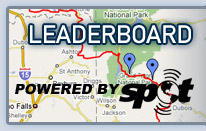Do you really want to race the GDMBR?
Self-supported Divide racing is based on an open, standing challenge (circa 1999) to cycle the Great Divide MTB Route as fast as humanly possible. Tackle it truly solo or as part of a common start, but do it all yourself; all the pedaling, navigation, resupply and camping; all the suffering. Indeed, with zero on-the-ground administration by organizers, the idea of Divide racing as an 'event' is mainly a construct of the online community that follows it. To these voyeurs, it's virtual racing at its finest. To challengers themselves, it is ultimately just a really long, lonely, sometimes lovely, solo bike ride.
Background: As all-American as racing is, ACA never imagined such a niche for their off-pavement touring route when they created it in 1997. But just as the interstate highway system is to RAAM, so too is the GDMBR to Divide racing. John Stamstad inaugurated the challenge when he blazed the the first self-supported Individual Time Trial (ITT) in 1999. In 2003 Mike Curiak was first to accept John's double-dare. Mike's ITT would end early, but he returned the next summer to organize a multi-up format called the Great Divide Race. Six other ambitious riders lined up for the masochism. When the dust settled, Curiak and runner-up Pete Basinger knocked 2 days off Stamstad's benchmark. Since then 'grand departs' (group starts) have been the fashion, but it's important to emphasize--like Stamstad in `99 and Curiak in `03--a challenger may race the route at any time during snow-free months in the Rockies. As long as an ITT performance is self-supported and strictly follows the route (see Rules), it is eligible for the annual General Classification.
Divide racing fundamentals look much like traditional touring: rider + gear vs. GDMBR + nature. It's the method that differentiates the racing: self-support + 'blitzkrieg'. Blitzkrieg is German for lightning war. It's how Divide racing is meant to be executed; move fast, send no postcards, 'take no prisoners' and 'hurt so good' (suffer well). To wit: Divide racing isn't your parent's 1976 Bikecentennial tour. Yes, the common denominator is to finish the route, but the inspiration is how quickly without cracking; to teeter on the edge physically and tackle headlong the emotional rollercoaster sure to coincide. Divide racing is not to be confused, even with fast-touring of today's ultralight set. It is exceedingly difficult simply by the sheer volume of daily miles, which are a primary reason it flaunts a heart-breaking 60% attrition rate.
Self-supported grand tour racing (ie. >2 weeks) along the GDMBR is like none other. Simply on scale, it's the hardest form of bike racing, period. To be competitive for the overall, one must ride ≥150 miles/day. There are no rest days. And if volume alone isn't taxing enough, one must also navigate, acquire resupply, clean/wrench the bike, find shelter each night, bathe when possible, and keep one's wits about it all. No entourages follow athletes. It cannot be compared to today's 100-milers, 24hour racing, or even 3-5 day stage race events.
Many wonder if they're capable of such a true solo blitz. At some point there's an inevitable leap of faith into grand tour racing. One thing is for certain: 2-3 weeks of back-to-back 16-18 hour days in the saddle are certain to bring about changes in body, mind and equipment of even the world's most seasoned ultra-endurance althlete. Are you the type to roll easily with this painful transformation? How well do you suffer for days on end? Are you prone to depression? Can you be happy sleeping in the dirt as it rains all night? Does post-holing through thigh-deep snowdrifts over a 10,000-ft pass sound like fun? A robust Rockies winter + late spring can leave behind just such mid-June diversion on the GDMBR.
It's easy to be attracted to the romance and camaraderie of a 'shared' cross-country MTB adventure. The rugged Divide backcountry is not the place to learn solo 'racing' is not your speed or style. Are you a seasoned multi-day bikepacker? Have you ridden back-to-back off-road centuries? Are you an expert level mountain biker? Are you a veteran of Primal Quest-scale multi-day adventure races? Are you a proficient bike mechanic; skilled navigator; competent at self-rescue? If you cannot confidently answer yes to most of the above, it would be wise to consider simply touring the route or taking more time to prepare for a true blitz.






